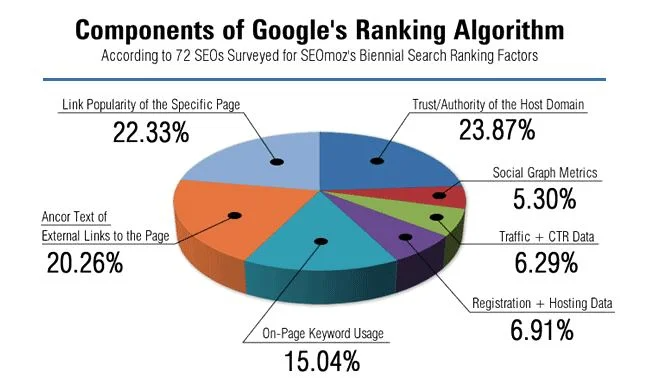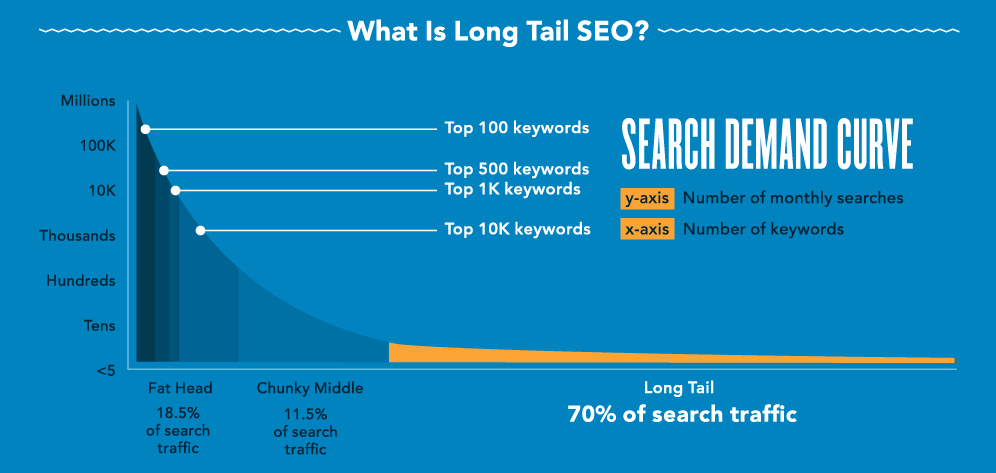Keywords
Use Keywords in your Driving School Website
Take a look at the components of the Google Ranking Algorithm:

On-Page Keyword Usage plays a major role in Google's algorithmic search formula.
What are Keywords
Keywords are essentially search phrases, search terms and critical elements of longer search phrases that you compete for in Google search.
ADI's want to include words learner drivers will search for throughout their content. But, do it sparingly. If you go overboard saturating your site with keywords, Google will pick up on this, and it will have an adverse effect on your ranking.
An ideal keyword density is around 1-2%. This means the target keyword should appear about one or two times per 100 words.
Keywords should fit naturally into sentences.
Include keywords in your header tags, meta-coding and in the meta-images.
One of the most effective SEO tactics driving instructor websites can employ, however, is to use long-tail keywords because they always work, especially in a saturated, niche market like the ADI industry. Using the long-tail keyword SEO tactic can allow your site to be captured by Google search results even in an area crowded with driving instructors.
What are long-tail keywords?
Long-tail keywords are precise key phrases that focus on one particular topic. They are usually key phrases which are three, four even five word phrases or more that could be found in a search.
Why should you care about long-tail keywords?
Google receives up to 70,800 search results per month in the UK for 'driving lessons', reflecting how online marketing within the driving instructing business can be a very saturated niche.
Self-employed ADI's who are competing for 'normal' keywords will struggle with the intense competition and the way to overcome this is to aim to rank for more targeted keywords by adding some more long-tail keyword power to the mix.
For instance, learner drivers will not just search for the word 'driving lesson' and if they do your site is highly unlikely to appear on page one (1) of the search result. Invariably they will also type in an additional word, possibly two or three, after 'driving lessons' to describe where it is they want to find a driving instructor, and/or even the type of lesson. So, for example, potential pupils may type into the search box any combination of: -
'driving lessons in S6' or 'manual driving lessons in Hillsborough' or 'cheap driving lessons in Sheffield' or 'automatic driving lessons in South Yorkshire' etc.
For the search engine to capture your site, you need to enter in your site's coding every combination of these type of driving lessons and location name keywords that the searcher might possibly enter. So in your sites coding you might insert: -
cheap-manual-driving-lessons-in-Hillsborough-Sheffield-S6-South-Yorkshire
You must therefore strategically place long-tail keywords into your site. You don't necessarily need to enter the exact key phrase match of words as the searcher. If you thoroughly list all the keywords and location names (and do include the postcodes that immediately surround you, if you cover them), if your choice of keywords match their search requirements, the search engines will capture your site and it will have a greater chance of getting ranked highly through organic search results.
Long-tail keyword SEO strategy
If you look at the image below, while highly searched for keywords like 'driving lessons' receive a huge amount of website traffic (left side of graph), we can also see that 70% of search traffic is in the long-tail keywords and this is where ADI sites need to be, in the chunky middle and to the right. This long-tail SEO strategy will help ADI's optimize their website, by aiming not to rank for just one, two or three keywords. Your goal is to rank for as many searches in the long-tail as you can. How do you do that? You start with keyword research.

How can I choose the right keywords
You can use Google's keyword research tool or Moz Keyword Explorer or Moz Pro or Bing Keyword Research or Wordtracker or SEO book or Search Engine Watch or Word Stream to help you find the keywords that are most relevant to your driving school business.
Using Google Keyword Planner as a long tail keyword Generator
Google’s Keyword Planner, which is part of Google Adwords, is a handy tool when looking for keyword suggestions. It’s part of Adwords and registration is free. Once signed up to Adwords you can use Keyword Planner, which isn’t a true SEO keyword tool as such, but an advertising tool to help you choose the right words for your online marketing campaign, however, you can also use it for SEO. In fact, the Keyword Planner is probably the best tool when you are looking for a list of seemingly unlimited long-tail keywords and there are no limitations on the number of results you can get and it's all free.
How to use Google search as a long-tail keyword research tool
Google search provides two features that can be very useful if you want to find more related long-tail keywords
Autocomplete - is what happens when you start typing into Google search. Google begins to suggest what you want to search for automatically and these suggestions are often great long-tail keywords that ADI's can use. In this instance, as we begin to type 'driving lessons in nottingham ...' Google throws up other possible suggestions learner drivers may use to search. If any relate to the service you're offering, start listing them and get them in your site. 
Another feature of Google’s search is the Related Searches box that appears below the search results:
 As you can see, Google search can also give you some useful long-tail keyword suggestions.
As you can see, Google search can also give you some useful long-tail keyword suggestions.
ADI's should discover which keywords and phrases learner drivers in their own locality enter in their search while looking to book driving lessons with a driving instructor. Start making an exhaustive list. (If we manage your site, we do this for you. We already have all the generic phrases Googled across the country incorporated in our ADI website template. We only need the geographical names you serve)
The idea is to find as many long-tail keywords as possible. Not just one even 10, but aim for 50 and many more. Aim to capture 90+% of website traffic using long-tail keywords by using every possible combination of high-level keywords that have some single or a few words added. When you use this many long-tail keywords, you are effectively optimizing not just for those keywords but for the complete long-tail. This is because your long-tail keywords will be very close to most of the remaining long-tail searches.
How do you optimize content for long-tail keywords?
Now that you know how to find keywords and you've got your exhaustive list, let’s look at content optimization. A mistake ADI's make when optimizing for long-tail keywords is they optimize for one or two keywords only. This is a mistake because actually, long-tail keywords are much easier to rank for. You can and you must optimize for many more than only one keyword.
For those of you using Wordpress, it's understandable you may only optimise for one keyword, because we know the available and most commonly used SEO optimization plugins in WordPress seemingly compel you to optimize for just one keyword, three at most. This doesn't mean, however, that you have to work like this alone.
For example, our ADI website template has an 'About you' page. Once we've encouraged our ADI's to write their own bio explaining who they are, the areas they cover, their driving instructing qualifications etc. Once that's complete you enter the second phase of SEO-optimization which involves you slipping into your pages all your keyword research wherever it makes sense. Add the phrases into your pages to ensure it's optimised at least in no small degree for your long-tail keywords. (if we manage your site - we do this for you). Periodically review your old pages, keep them current and up to date, sprinkle in a few more keywords throughout your content. You will always find more opportunities and this SEO-optimisation process should be continuously refined because it will help your site get captured in the search results for more high-level keywords, helping you to generate an increase in site traffic.
Where shall I put the long tail keywords in my website
As well as in the content, make sure your meta-images, meta-tags, meta-descriptions, meta-coding, URL's and H1, H2, H3, H4 header tags all include in moderation your long-tail keywords, which includes your core driving school catchment area names. (A whole lot more on this soon .... there are lots of nice tips you can use to manipulate your site's coding to ensure it ranks highly in Google SERP's)
Final words
In this post, ADI's should have learned what keywords are, how to research them, and how long-tail keywords will increase 'learner driver' search traffic to your pages.
Using long tail keywords is a very effective SEO tactic that can help you generate targeted website traffic even in a crowded and saturated niche.
Note: If we manage your site, be rest assured that we have done a complete and exhaustive keyword research on what learner drivers Google and all these long-tail keywords have been incorporated into our master driving school website template. We then customise the meta coding to ensure that the keywords relevant to your specific area in the UK and your driving school are strategically placed in your site which is why it's truly SEO-optimised to you.
Need SEO help? We have numerous examples of SEO success. Copy paste 'cheap family mobile homes near Disneyland Paris' or any combination of these words and at the top of Google page 1 is www.mobilehomelets.co.uk in the USA, UK, Europe, Far East, beating TripAdvisor etc. That's because of us!
Click here if you need a new, clean, modern, SEO-optimised, mobile-friendly, responsive
Driving School Website template
www.drivinginstructorwebsites.co.uk is a participant in the Amazon Services LLC Associates Program, an affiliate advertising program designed to provide a means for sites to earn advertising fees by advertising and linking to amazon.com. As an Amazon Associate, I earn from qualifying purchases. www.drivinginstructorwebsites.co.uk participates in various other affiliate programs, and we sometimes get commission through purchases made through our links.
